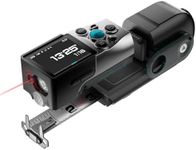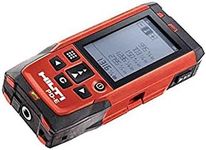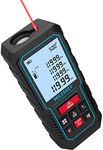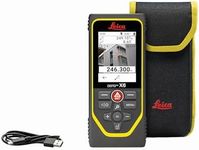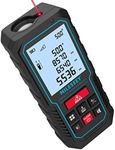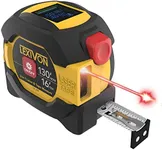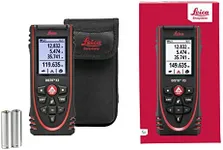Buying Guide for the Best Laser Measures
Choosing the right laser measure can make your measuring tasks faster, more accurate, and much easier than using a traditional tape measure. Before you buy, think about where and how you’ll use it—indoors or outdoors, for small rooms or large spaces, for simple measurements or more complex calculations. Understanding the key features will help you pick a device that matches your needs and avoids paying for extras you won’t use.Measuring RangeMeasuring range tells you the maximum distance the laser measure can accurately record. This is important because it determines whether the device can handle the spaces you plan to measure. Short ranges (up to 30 meters or about 100 feet) are great for indoor use, like measuring rooms or furniture. Medium ranges (up to 50 meters or about 165 feet) suit larger homes or small commercial spaces. Long ranges (over 50 meters) are best for big construction sites or outdoor use. Choose a range that covers your typical measuring needs, but remember that longer ranges can be less accurate indoors due to reflections.
AccuracyAccuracy tells you how close the measurement will be to the actual distance. It’s usually shown as plus or minus a few millimeters. High accuracy (±1 mm) is important for tasks like interior design or carpentry, where small errors matter. For general home use, a slightly lower accuracy (±2-3 mm) is often enough. Think about how precise your measurements need to be—if you’re doing detailed work, prioritize higher accuracy.
Display TypeThe display shows your measurements and sometimes extra information. Basic models have simple screens that show just the numbers, while advanced ones might have backlit or color screens for better visibility, especially in low light. If you often work in dim areas or outdoors, a clear, bright display will make reading measurements easier. For occasional indoor use, a basic display is usually fine.
Functions and ModesLaser measures can do more than just measure distance. Some offer area, volume, continuous measurement, indirect (Pythagoras) measurement, and memory storage. If you only need to measure straight lines, a basic model is enough. If you want to calculate room sizes, ceiling heights, or need to measure around obstacles, look for extra functions. Match the features to your typical projects—more functions are helpful for professionals or frequent users.
Durability and ProtectionDurability refers to how well the device can handle drops, dust, and water. Some laser measures are rated with IP (Ingress Protection) codes, showing resistance to dust and water. If you’ll use the device on construction sites or outdoors, look for higher protection ratings and rubberized casings. For home or office use, basic protection is usually enough. Think about your work environment to decide how tough your device needs to be.
Battery Type and LifeLaser measures run on batteries, which can be standard (like AA or AAA) or rechargeable. Battery life affects how often you’ll need to replace or recharge. If you use the device often or for long periods, longer battery life or rechargeable options are more convenient. For occasional use, standard batteries are usually fine and easy to replace. Consider how often you’ll use the device and whether you prefer the convenience of recharging or swapping batteries.
Size and WeightThe size and weight of a laser measure affect how easy it is to carry and use. Compact, lightweight models are easy to slip into a pocket and use with one hand, making them great for quick jobs or frequent travel. Larger models may offer more features but can be bulkier. Think about whether you need portability or if you’re okay with a bigger device for extra functions.
